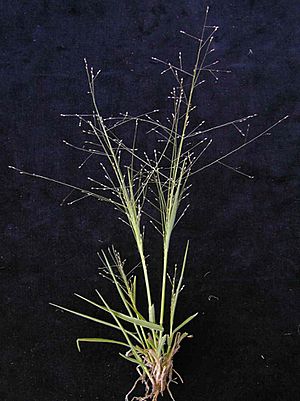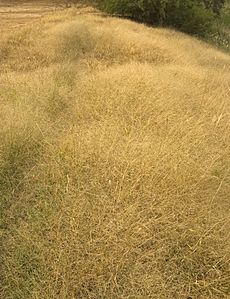Hairy panic facts for kids
Quick facts for kids Hairy panic |
|
|---|---|
 |
|
| Conservation status | |
| Scientific classification | |
| Genus: |
Panicum
|
| Species: |
effusum
|
| Synonyms | |
|
Panicum convallium F.Muell. |
|
Hairy panic (scientific name: Panicum effusum) is a type of grass that grows naturally in the dry, inland parts of Australia. You can find it in every state on the mainland, and also in New Guinea. When conditions are very dry, this fast-growing grass can turn into a tumbleweed. A tumbleweed is a plant that breaks off from its roots and rolls away in the wind, spreading its seeds.
Contents
What Does Hairy Panic Look Like?
Hairy panic is a grass that lives for many years. It can grow up to 70 centimeters (about 2.3 feet) tall. Its leaves have tiny hairs and can be 5 to 30 centimeters long and 0.4 to 1 centimeter wide. The parts that hold the seeds, called spikelets, are usually 5 to 50 centimeters long. Each spikelet is about 2 to 3 millimeters long.
The Name of Hairy Panic
A Scottish plant expert named Robert Brown first described Panicum effusum in 1810. It still has the same scientific name today. Another botanist, Ferdinand von Mueller, described a similar plant in 1855.
This grass has many common names. People call it branched panic, hairy panic, effuse panic, native millet, and poison panic.
Where Does Hairy Panic Live?
You can find hairy panic all over Australia, especially in the eastern parts, and also in Papua New Guinea. It likes to grow in clay soils that don't have too many nutrients. These soils are often found over shale or conglomerate rock.
Because hairy panic is found in many places, is very common, and its numbers are stable, it is listed as "Least Concern" by the IUCN Red List. This means it is not currently at risk of disappearing. In fact, it might even be becoming more common.
Hairy panic grows in many different environments in Australia. These include shrublands, grasslands, tropical savannas, deserts, woodlands, rainforests, and even areas near mountains and coasts.
How Hairy Panic Grows and Spreads
Panicum effusum produces a dry, single seed that does not open to release the seed. These seeds are eaten by birds like the stubble quail. The seeds can be carried by the wind. They can also travel in mud stuck to cars.
This plant flowers during the summer months. It can handle very dry weather well, but it doesn't do well in frost.
Hairy Panic as a Tumbleweed
When the weather is extremely dry, this fast-growing grass can become a tumbleweed. This is a way the plant spreads its seeds. Sometimes, these rolling masses of grass can become a problem in towns.
For example, in February 2016, the town of Wangaratta, Victoria, was covered by huge amounts of hairy panic tumbleweeds. They piled up so high that they reached the roofs of houses! Some people thought a local farmer was to blame because he hadn't looked after his paddock (a field for animals).
Hairy panic uses a special way to make its food, called C4 carbon fixation. This helps it grow better in hot and dry conditions.
What is Hairy Panic Used For?
Hairy panic is part of the grass that animals eat in pastures, but it's usually not the main type of grass. It has some nutritional value for livestock like sheep. However, if sheep eat a lot of hairy panic within a few weeks after rain, they can get sick. They might develop a condition that makes their skin sensitive to sunlight, or a serious illness called “yellow-bighead.”
This grass also has some value as a bush food. Its seeds can be ground into flour and baked. Even though there are many seeds, they can be hard to collect.



